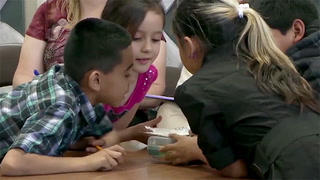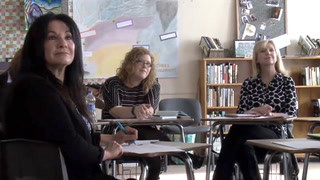Conver-Stations: A Discussion Strategy Transcript
Speaker 1: Movement in any lesson is important. Sometimes we move kids in traditional ways by having entire groups of students get up and move around to different places in the room. Today I wanted to introduce them to the idea of conver-stations.
This is what we're going to do. We're going to get back into the books. We're going to do a little investigation of evil. But I'm going to ask you to do a little moving around the classroom. I'm going to ask you to start to talk to some different people.
A component of the group was going to stay stationary, but as the conversation shifted, some of the students in each group would move. And in that sense we created these stations for conversing.
Speaker 2: One of the very lowest ones is not only you're physically abusing someone but you're mentally abusing them and -
Speaker 1: All right. How are we doing? You're having these really great conversations but we need to carry those conversations around the classroom. We're going to do just a little rotation here. I'm going to have two of you rotate here, two of you rotate here.
I just knew that they needed to talk to different people and I still wanted there to be movement in the classroom. So I asked each group to send two people to the next group and they did that.
Pick the two people. You're going to rotate. And then we're going to come back together, and I'll tell you what we're going to do as a group. Okay? Up and move. 30 seconds.
It was really important to make sure that there was that continuous movement in the classroom because I wasn't leading the conversation.
Speaker 3: So I feel like that's [?] he's trying to test [is not?] necessarily evil. It's just trying to see how the mind works, I guess.
Speaker 1: The students were leading those conversations. But we don't want those conversations to stay in isolation.
Speaker 4: We're talking about the idea of the attack that's going to happen soon.
Speaker 1: And as students move from one conversation to the next, they're taking some of that with them.
Speaker 5: You have to convince people, to make it seem right.
Speaker 6: But they come from two separate backgrounds. Does that really justify it?
Speaker 1: Hey, everybody. As you're talking, write down these really good moments. Because I'm hearing really good things that you're saying, but you're going to need them at the end of class. So when somebody says something and you think, "That was good," write it down.
So the next time it was time to shift the conversation, two different people came and moved.
So we're going to have two people again to each, but two people who did not move last time. All right. So, go ahead. Two people move.
It's this idea that you are synthesizing, really the conversations from quite a few groups, into these smaller groups.
Here at the end of class, the conver-stations really provide this foundation for students to deepen their thinking about an essential question.
You get to sit down if you choose to share your response. Who's up for it? Okay, here we go.
Speaker 7: The impact of evil in Heart of Darkness is that it leads to dehumanization through greed, cruelty and hatred, suggesting that the impact of cruelty upon the [Congolese?] derived from [grief?].
Speaker 1: Wow. Wow, that's fantastic.
It was a pretty seamless way to change groups without the whole class having this complete fruit basket upset.
















98 Comments
Mary Salmon Jun 19, 2020 8:27pm
This strategy was used to lead small group discussions. Students changed stations two at time, this allowed them to move quickly and smoothly. Class was well managed and students were engaged and followed directions.
Gladys Rivera May 11, 2020 7:05pm
Gladys Rivera May, 11, 2020 5:52pm
Awesome strategy! I like the idea on how to use this instructional strategy in my Spanish Literature class, allowed constant conversation and disscutions.
Tracy Opoka Mar 14, 2020 11:57am
What was in the paint strips? And after each rotation was there a different question for each group......I'm wondering, did the 2 people who didn't rotate first discuss the same question as before????
Raven Groom May 24, 2018 2:14pm
Pamela Johnson May 14, 2018 12:38am